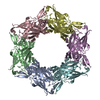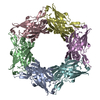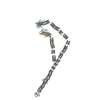[English] 日本語
 Yorodumi
Yorodumi- PDB-3j2o: Model of the bacteriophage T4 fibritin based on the cryo-EM recon... -
+ Open data
Open data
- Basic information
Basic information
| Entry | Database: PDB / ID: 3j2o | ||||||
|---|---|---|---|---|---|---|---|
| Title | Model of the bacteriophage T4 fibritin based on the cryo-EM reconstruction of the contracted T4 tail containing the phage collar and whiskers | ||||||
 Components Components | Fibritin | ||||||
 Keywords Keywords | VIRAL PROTEIN / Bacteriophage T4 / phage neck / collar whiskers / fibritin / gpwac | ||||||
| Function / homology | Fibritin C-terminal / Fibritin C-terminal region / virion component / Fibritin Function and homology information Function and homology information | ||||||
| Biological species |  Enterobacteria phage T4 (virus) Enterobacteria phage T4 (virus) | ||||||
| Method | ELECTRON MICROSCOPY / single particle reconstruction / cryo EM / Resolution: 25 Å | ||||||
 Authors Authors | Fokine, A. / Zhang, Z. / Kanamaru, S. / Bowman, V.D. / Aksyuk, A.A. / Arisaka, F. / Rao, V.B. / Rossmann, M.G. | ||||||
 Citation Citation |  Journal: J Mol Biol / Year: 2013 Journal: J Mol Biol / Year: 2013Title: The molecular architecture of the bacteriophage T4 neck. Authors: Andrei Fokine / Zhihong Zhang / Shuji Kanamaru / Valorie D Bowman / Anastasia A Aksyuk / Fumio Arisaka / Venigalla B Rao / Michael G Rossmann /  Abstract: A hexamer of the bacteriophage T4 tail terminator protein, gp15, attaches to the top of the phage tail stabilizing the contractile sheath and forming the interface for binding of the independently ...A hexamer of the bacteriophage T4 tail terminator protein, gp15, attaches to the top of the phage tail stabilizing the contractile sheath and forming the interface for binding of the independently assembled head. Here we report the crystal structure of the gp15 hexamer, describe its interactions in T4 virions that have either an extended tail or a contracted tail, and discuss its structural relationship to other phage proteins. The neck of T4 virions is decorated by the "collar" and "whiskers", made of fibritin molecules. Fibritin acts as a chaperone helping to attach the long tail fibers to the virus during the assembly process. The collar and whiskers are environment-sensing devices, regulating the retraction of the long tail fibers under unfavorable conditions, thus preventing infection. Cryo-electron microscopy analysis suggests that twelve fibritin molecules attach to the phage neck with six molecules forming the collar and six molecules forming the whiskers. | ||||||
| History |
|
- Structure visualization
Structure visualization
| Movie |
 Movie viewer Movie viewer |
|---|---|
| Structure viewer | Molecule:  Molmil Molmil Jmol/JSmol Jmol/JSmol |
- Downloads & links
Downloads & links
- Download
Download
| PDBx/mmCIF format |  3j2o.cif.gz 3j2o.cif.gz | 71.8 KB | Display |  PDBx/mmCIF format PDBx/mmCIF format |
|---|---|---|---|---|
| PDB format |  pdb3j2o.ent.gz pdb3j2o.ent.gz | 41.2 KB | Display |  PDB format PDB format |
| PDBx/mmJSON format |  3j2o.json.gz 3j2o.json.gz | Tree view |  PDBx/mmJSON format PDBx/mmJSON format | |
| Others |  Other downloads Other downloads |
-Validation report
| Summary document |  3j2o_validation.pdf.gz 3j2o_validation.pdf.gz | 761 KB | Display |  wwPDB validaton report wwPDB validaton report |
|---|---|---|---|---|
| Full document |  3j2o_full_validation.pdf.gz 3j2o_full_validation.pdf.gz | 760.5 KB | Display | |
| Data in XML |  3j2o_validation.xml.gz 3j2o_validation.xml.gz | 24 KB | Display | |
| Data in CIF |  3j2o_validation.cif.gz 3j2o_validation.cif.gz | 35.3 KB | Display | |
| Arichive directory |  https://data.pdbj.org/pub/pdb/validation_reports/j2/3j2o https://data.pdbj.org/pub/pdb/validation_reports/j2/3j2o ftp://data.pdbj.org/pub/pdb/validation_reports/j2/3j2o ftp://data.pdbj.org/pub/pdb/validation_reports/j2/3j2o | HTTPS FTP |
-Related structure data
| Related structure data |  5528MC  3j2mC  3j2nC  4hudC  4huhC M: map data used to model this data C: citing same article ( |
|---|---|
| Similar structure data |
- Links
Links
- Assembly
Assembly
| Deposited unit | 
|
|---|---|
| 1 |
|
- Components
Components
| #1: Protein | Mass: 51777.973 Da / Num. of mol.: 6 Source method: isolated from a genetically manipulated source Source: (gene. exp.)  Enterobacteria phage T4 (virus) / Gene: wac / Production host: Enterobacteria phage T4 (virus) / Gene: wac / Production host:  |
|---|
-Experimental details
-Experiment
| Experiment | Method: ELECTRON MICROSCOPY |
|---|---|
| EM experiment | Aggregation state: PARTICLE / 3D reconstruction method: single particle reconstruction |
- Sample preparation
Sample preparation
| Component |
| |||||||||||||||
|---|---|---|---|---|---|---|---|---|---|---|---|---|---|---|---|---|
| Buffer solution | Name: 50 mM Tris-HCl, pH 8.0, 0.2 M NaCl, 8 mM MgCl2 / pH: 8 / Details: 50 mM Tris-HCl, pH 8.0, 0.2 M NaCl, 8 mM MgCl2 | |||||||||||||||
| Specimen | Embedding applied: NO / Shadowing applied: NO / Staining applied: NO / Vitrification applied: YES | |||||||||||||||
| Vitrification | Instrument: HOMEMADE PLUNGER / Cryogen name: ETHANE / Details: plunged into liquid ethane (homemade plunger) |
- Electron microscopy imaging
Electron microscopy imaging
| Microscopy | Model: FEI/PHILIPS CM200FEG / Date: Mar 7, 2007 |
|---|---|
| Electron gun | Electron source:  FIELD EMISSION GUN / Accelerating voltage: 200 kV / Illumination mode: SPOT SCAN FIELD EMISSION GUN / Accelerating voltage: 200 kV / Illumination mode: SPOT SCAN |
| Electron lens | Mode: BRIGHT FIELD / Nominal magnification: 38000 X / Calibrated magnification: 39190 X / Nominal defocus max: 3000 nm / Nominal defocus min: 1500 nm / Cs: 2 mm |
| Specimen holder | Specimen holder model: GATAN LIQUID NITROGEN |
| Image recording | Electron dose: 16 e/Å2 / Film or detector model: KODAK SO-163 FILM / Details: Kodak film |
| Image scans | Num. digital images: 97 |
| Radiation | Protocol: SINGLE WAVELENGTH / Monochromatic (M) / Laue (L): M / Scattering type: x-ray |
| Radiation wavelength | Relative weight: 1 |
- Processing
Processing
| EM software |
| ||||||||||||
|---|---|---|---|---|---|---|---|---|---|---|---|---|---|
| CTF correction | Details: phase flipping | ||||||||||||
| Symmetry | Point symmetry: C1 (asymmetric) | ||||||||||||
| 3D reconstruction | Method: projection matching / Resolution: 25 Å / Resolution method: FSC 0.5 CUT-OFF / Num. of particles: 2727 / Nominal pixel size: 3.572 Å / Actual pixel size: 3.572 Å / Symmetry type: POINT | ||||||||||||
| Atomic model building | Space: REAL Details: DETAILS--The model of fibritin comprises the crystal structure of the N-terminal domain (Boudko et al., 2004, J. Mol. Biol. 339, 927-935), the crystal structure of the C-terminal domain (Tao ...Details: DETAILS--The model of fibritin comprises the crystal structure of the N-terminal domain (Boudko et al., 2004, J. Mol. Biol. 339, 927-935), the crystal structure of the C-terminal domain (Tao et al., 1997, Structure 5, 789-798), and the central region, modeled with segments of triple-helical coiled coil (Letarov et al., 2005, J. Bacteriol. 187, 1055-1066). These parts of the fibritin structure were fitted into the cryo-EM density using the program CHIMERA (Pettersen et al., 2004, J. Computat. Chem. 25, 1605-1612). Chains A, B, and C correspond to one fibritin molecule located in the phage collar. Chains D, E, and F correspond to one fibritin molecule forming the whisker. | ||||||||||||
| Refinement step | Cycle: LAST
|
 Movie
Movie Controller
Controller










 PDBj
PDBj

